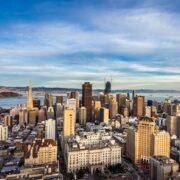
THE Bay Area reached a new high of COVID-19 cases as the count for positive cases reached 50,472 with 785 deaths, as of Wednesday morning, July 29.
San Francisco reported 132 new cases from Tuesday, July 28, bringing its new total to 6,197. In San Mateo County, 108 new cases were reported, adding to its new total of 5,306.
Alameda County remained the Bay Area county with the highest coronavirus count with 10,633 confirmed cases, followed by Santa Clara (9,359) and Contra Costa (7,304).
Bay Area counties with the least number of cases were Solano (3,388), Sonoma (2,662), Marin (2,649), and Napa (806), as of early Wednesday.
Cases across the state continued to rise as California, on Wednesday, broke another new grim record for COVID-19 related deaths in a single day for the fourth time this month.
California reported 174 deaths on Tuesday, breaking the previous 159 death record count on July 23.
On average, the daily count of coronavirus-related deaths over the past seven days has been the highest it’s ever been at 119.
“Tragically, CA surpassed another somber milestone today,” California Governor Gavin Newsom tweeted Tuesday with the state’s latest numbers.. “Please — WEAR A MASK.”
State health officials double down on case for masks
The rising numbers come as California — despite being the first state to order safer-at-home mandates — overtook New York last week as the state with the highest number of coronavirus infections since the outbreak reached the U.S.
Modoc County, the last county in California to have had a long streak of no cases, reported its first two cases on Tuesday and urged those who were in any of the county’s bars in the last two weeks to contact health authorities.
In an effort to stem the spread of the virus, state health officials doubled down on the importance of wearing masks, saying that the spread of the virus could be cut by at least half if more people wore masks.
California Health and Human Services Secretary Dr. Mark Ghaly said on Tuesday that wearing masks, along with maintaining physical distance and hand washing, was “increasingly one of those powerful tools that we see, not just at the aggregate but on the individual level to protect your communities, your local hospital system.”
“If we had 80% compliance with masking, we could reduce transmission somewhere between 50% to 60%, which is tremendous,” said Ghaly. “That’s exactly what we need to see the case numbers come down, even if we don’t necessarily change the level of mixing that we’re having in our communities.”
California residents have long been strongly encouraged to wear masks, yet enforcement has been left up to local governments. Many have increasingly started fining people caught in public without masks.
“We’ve largely left that to the local level,” said Ghaly. “We’ve seen more and more local jurisdictions consider fines for lack of compliance.”
Contra Costa County was among the latest to give county officials the green light to cite people who fail to follow public health guidelines like wearing masks in indoor public areas, with fines starting at $100, then increasing to $200 and $500 for repeat violations.
Other Bay Area counties handing out fines include Napa, Alameda, Monterey, Salinas, and Marin counties.
While Newsom has not required counties to fine mask violations, he did issue a statewide mask order on June 18.
Ghaly said it was possible that Newsom would withhold coronavirus aid and funding to counties and cities if they failed to enforce state orders.
The city of Atwater in Merced County missed out on about $65,000 after it allowed businesses to remain open against state orders.
There has been some resistance to mask wearing from communities like in Southern California’s Huntington Beach, however recent polls suggest that a majority of Americans are okay with wearing masks.
Recently released results from a Associated Press—NORC Center for Public Affairs Research survey conducted from July 16 to July 20 found that 75% of Americans supported a face mask requirement.
Furthermore, 72% wanted their community to put restrictions to help slow the spread of the coronavirus, even at the expense of the economy.
“Having that mask on or handy is a very important tool as we continue to see the evidence grow that it can help reduce the spread of COVID-19 and not only protect our families and communities but help us move on the road of economic recovery, help us get closer to having more schools open across the state,” said Ghaly.






